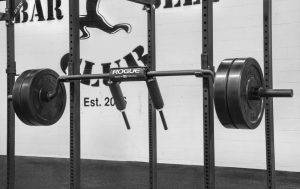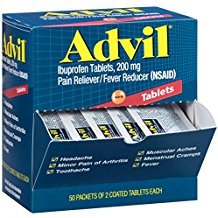If I had to pick one “injury” that is by far the most common among all the powerlifters that I’ve worked with, it would easily be some kind of tendinitis from low bar squatting. Whether that manifests as shoulder pain, bicep pain, or elbow pain, this happens to seemingly every single powerlifter in existence at some point in their career. I’ve dealt it with personally so many times that I have refined an entire system for dealing with the problem.
In this article, I want to share my experiences on how you can manage this problem and, ideally, eliminate or prevent it from happening altogether. In order to do that, we’re going to take a multi-faceted approach to the problem that includes: 1) mobility, 2) technique, 3) programming, and 4) prehab/rehab.
If you’d rather watch than read:
Why does Elbow Pain Happen?
One of the most important concepts you can understand about tendinitis is that it is, essentially, an overuse injury. In other words, for whatever reason, something that you’re doing is causing irritation to the soft tissue and the underlying structures therein. With repeated exposure to the irritant in question, the inflammation grows worse over time. Eventually, you’ll hit a tipping point where the pain becomes severe enough to inhibit normal function. Congratulations, you’ve now got a case of tendinitis.
In the case of low bar squats, there are at least two competing theories as to why this happens.
For one, there are those that say the low bar squat inherently loads the elbows and shoulders to some degree. While this may not be the case if your form is absolutely perfect and you’re carrying the bar in exactly the right spot, it is more or less true in reality due to the inevitability of form breakdown. When reps get hard, people drive their elbows under the bar or they drive their elbows up or any other number of things can happen. As a set progresses, the bar moves around on your back a little bit and sometimes slides down which can further load the shoulders and elbows to some degree. Again, if your form was perfect, you theoretically wouldn’t have to worry about this. However, most people don’t have perfect form in the real world and there can often be advantages to carrying the bar very low even if it does load the tendons and ligaments.
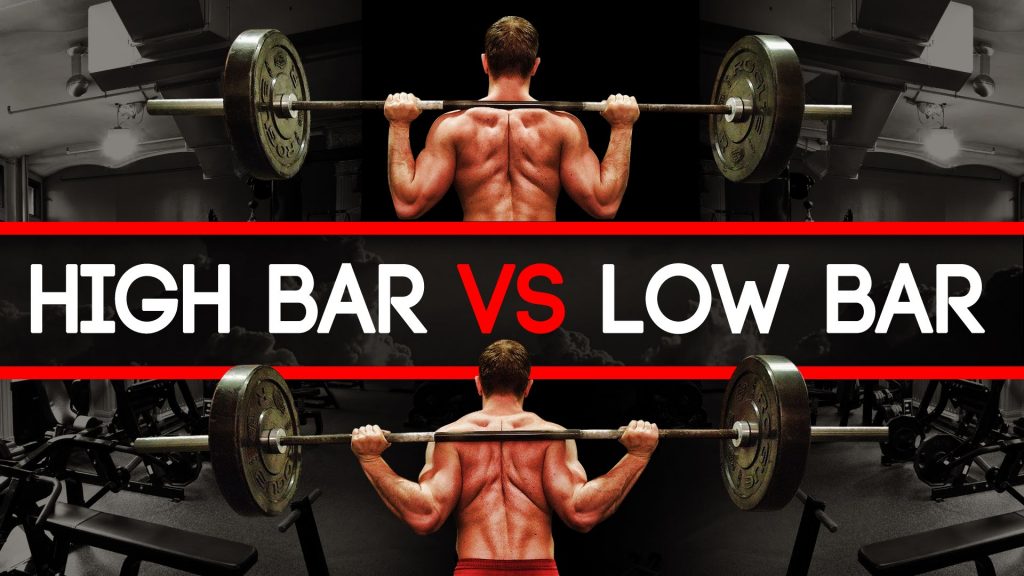
The low bar picture here is a great example of someone carrying the bar “too low”. credit: Scott Herman Fitness
The second reason that some people suggest low bar squats can cause tendinitis comes down to the mobility requirements of the movement. Powerlifter-types can often be stiff and lacking mobility. Let’s face it: low bar squats actually do require quite a bit of flexibility throughout the lats, chest, and shoulders. You’re jamming the bar pretty low on your back and this can require a significant amount of thoracic mobility as well as shoulder extension. Some people don’t have the requisite mobility for a true low bar squat, but they can still “jam” themselves into position using the weight of the bar. To compensate for this lack of mobility in the musculature, tendons and ligaments can actually mobilize to a small degree. When this happens, internal structures can impinge or rub against each other resulting in inflammation.
Mobility for Low Bar Squats
The first thing that everybody does when trying to address elbow and shoulder pain from low bar squatting is that they run out and find a list of mobility exercises to do. Look, that’s a great start, but I’d actually recommend approaching the situation from the other end of the spectrum. Instead, you should look for ways to REDUCE the mobility requirements of the movement in the first place.
The two main ways to do this are: 1) increase your grip width to reduce shoulder flexion/extension requirements and 2) allow your wrists to bend to reduce shoulder flexion/extension requirements. In some cases, you can fix the issue just by widening your grip. Almost EVERYONE will find relief in allowing their wrists to bend, though. Make sure that if you do allow the wrists to bend that you’re using wrist wraps. You don’t want your wrist joints to take a beating trying to support hundreds of pounds of load.

Straight wrist, thumbless grip (left) vs. the bent wrist, thumbs around grip (right). A bent wrist grip can really help with elbow tendinitis.

This is an extreme example but it clearly shows how the shoulder mobility demands are decreased as the grip widens.
Now, I know some of you would be pissed if I didn’t include my favorite mobility exercises for low bar squat. I think the two best ones are 1) shoulder dislocations and 2) the low bar squat stretch.
Shoulder dislocations are best done with a PVC pipe:
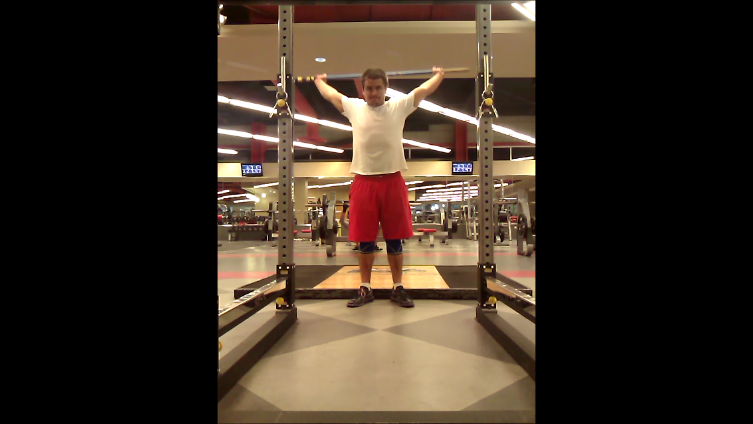
Shoulder dislocations will help you improve your mobility for low bar squats.
Here is a great demonstration of the best and most specific stretch to improving low bar squat mobility:
Technique to Reduce Low Bar Squat Pain
One of the biggest culprits to low bar squat pain is simply carrying the bar too low. If you carry the bar below the spine of the scapula, or below the rear delt muscles, there is pretty much no way to avoid loading the elbows and shoulders to some degree. Here is an exaggerated example to show what I’m talking about:
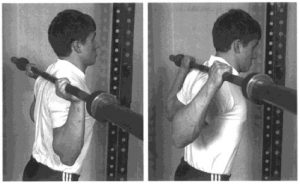
As you can see on the left, the bar is slightly too low and the lifter has no way to avoid significantly loading the elbows. Carrying it a little higher fixes this.
Now, some people can actually lift more weight when they carry the bar SUPER low, but this is an advanced technique and it really isn’t something you should be messing around with if you have tendinitis issues. Carry the bar a little higher and you won’t run into as many problems. Additionally, chalk the back of your shirt so that the bar is less likely to slide around during sets that have more than one rep. This makes a HUGE difference.
Programming to reduce Elbow Pain from Low Bar Squats
Remember, tendinitis is caused by repeated exposure to an irritating stimulus. In this case, that irritant is low bar squats. The more often you do low bar squats, the higher your chances of coming down with a case of tendinitis. One of the simplest and fastest ways you can reduce or eliminate this problem is to cut back on your low bar squatting. My practical recommendations are to cut back to once or twice per week as far as low bar squat frequency. That doesn’t mean that you need to cut back on squatting in general, though. There are many variations of squats that either reduce the mobility requirements for squatting significantly or avoid loading the elbows and shoulders. The best two are Safety Bar Squats and Buffalo Bar Squats.
Buffalo Bar squats are the most similar to a low bar squat, but due to the bow in the bar, the mobility demands are reduced significantly. This is due to the fact that the your hands don’t have to reach up as high to get a hold of the bar. That is all there is to it — very simple stuff. Buffalo Bar squats are a great alternative when you’ve got a minor case of tendinitis because, as I’ve said, they’re the most similar to a competition low bar squat.
The Safety Squat Bar is another beast entirely. The mechanics are very different than your typical low bar squat. A Safety Bar Squat is more like a hybrid between a front squat and a high bar squat. However, due to the way the bar is created, you don’t even have to use your arms. This can allow you to still get in some squatting even when you have devastating elbow pain. This bar has saved me during several meet preps when my elbow pain became too severe to do any kind of competition squatting.
More info on Safety Bar Squats:
Prehab/Rehab for Elbow and Shoulder Pain from Low Bar Squats
Research has shown that controlled, eccentric loading can be beneficial for tendon injuries. When it comes to elbow and bicep pain from low bar squats, my absolute FAVORITE exercise for “prehab” purposes is the dumbbell hammer curl. I recommend performing the exercise in typical bodybuilding fashion: do 8-15 rep sets while focusing on control and tempo. Really control the eccentric on the way down for the best results. I’m telling you this exercise provides almost immediate relief.

This one single exercise has helped my elbows more than anything else.
As far as rehab goes, you must understand that tendinitis is an overuse injury. You cannot train through tendinitis. This is just so key: YOU CANNOT TRAIN THROUGH TENDINITIS. Well, you can, but it will just get worse. You have to remove the irritant and allow this injury to heal. Once it has healed, you can reintroduce normal training. Just make sure that you actually address some of the things that caused the problems in the first place: 1) mobility, 2) technique, and 3) programming. You have to do SOMETHING differently or the tendinitis will just come back.
The severity of your personal case will determine what you can get away with doing while the injury heals. There have been times where I tried to train through this injury and it got so bad that I couldn’t sleep. I’ve had it get bad enough where I couldn’t do deadlifts and you don’t even bend your arm in that exercise. I’ve also had extremely minor cases that were fixed by simply replacing one low bar squat session with a Buffalo Bar session. So, as I’ve said, the severity of your case will determine what you can get away with doing while the injury heals. The big KEY here is to make sure you’re not doing ANYTHING that causes pain while it heals. One more time, do not do any exercise that causes even minor pain to the injury while you are letting it heal.
Ibuprofen: Last Resort Option
Look, this is isn’t medical advice and I’m not a trained professional. Nothing I say here should be considered a replacement for competent medical advice from a trained professional. All that said, you can mask tendinitis to some degree with NSAIDs. Anti-inflammatory drugs DO work for tendinitis because, well, tendinitis is essentially an inflammation-based injury. I would STRONGLY encourage you not to rely on ibuprofen and other NSAIDs, though. Not only is this extremely unhealthy but you WILL get to a point where you cannot train without them. At that point, you’re pretty screwed unless you want to pop pills before every workout for the rest of your life. Even then, sometimes the tendinitis gets so bad that the NSAIDs no longer help enough to make a difference. This is a last resort option that should be reserved exclusively for helping you get through the last couple weeks of a meet prep if this horrible issue just so happens to hit you hard during that crucial time.
Summary: How to Fix Elbow and Shoulder Pain from Low Bar Squats
- Mobility:
a. Improvement mobility throughout the lats, chest, and shoulders using shoulder dislocations and the low bar squat stretch
b. Reduce mobility requirements by widening your grip and/or allowing your wrists to bend while using wrist wraps - Technique
a. Carry the bar just a little higher!
b. Chalk your back to prevent the bar from sliding around during tough sets - Programming
a. Reduce your low bar squatting frequency
b. Consider using more elbow/shoulder friendly variations such as Safety Bar Squats or Buffalo Bar Squats - Prehab/Rehab
a. Controlled eccentric hammer curls help a TON with prehab
b. You CANNOT train through tendinitis, let it heal fully by doing ONLY pain-free exercises
c. Use NSAIDs as a last resort
Like this Article? Subscribe to our Newsletter!
If you liked this articled, and you want instant updates whenever we put out new content, including exclusive subscriber articles and videos, sign up to our Newsletter!
Questions? Comments?
For all business and personal coaching services related inqueries, please contact me:
